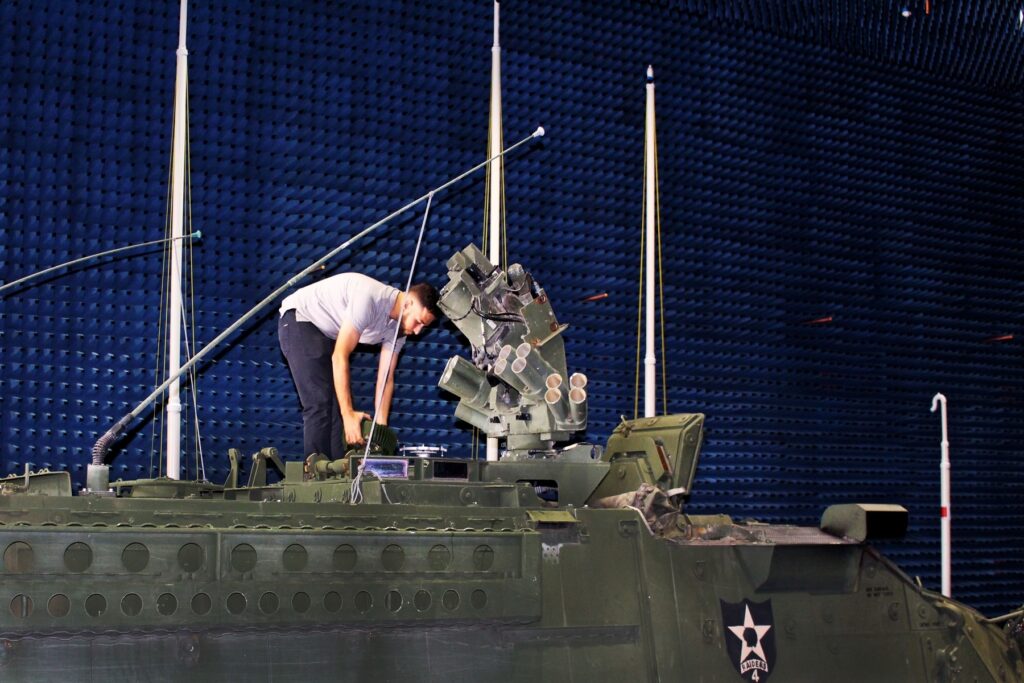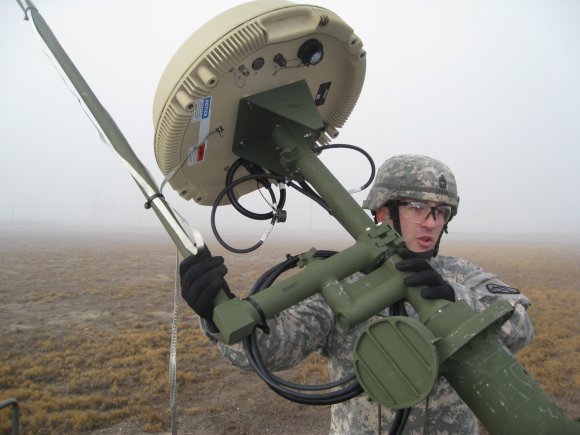By SYDNEY J. FREEDBERG JR
 Unlike the Taliban, Russia and China can shoot down our drones, jam our transmissions, and hack our computers. So to prepare to fight them, we need a very different communications network — one the US Army is now studying how to build. Installing a jamming-resistant antenna on an Army Stryker vehicle inside a massive anechoic test chamber. The revolution in warfare will not be televised. In a future great power conflict, American command posts won’t have the live video feeds our officers got accustomed to in Afghanistan and Iraq. Unlike the Taliban, Russia and China can shoot down our drones, jam our transmissions, and hack our computers. So to prepare to fight them, we need a very different communications network — one the US Army is now studying how to build.
Unlike the Taliban, Russia and China can shoot down our drones, jam our transmissions, and hack our computers. So to prepare to fight them, we need a very different communications network — one the US Army is now studying how to build. Installing a jamming-resistant antenna on an Army Stryker vehicle inside a massive anechoic test chamber. The revolution in warfare will not be televised. In a future great power conflict, American command posts won’t have the live video feeds our officers got accustomed to in Afghanistan and Iraq. Unlike the Taliban, Russia and China can shoot down our drones, jam our transmissions, and hack our computers. So to prepare to fight them, we need a very different communications network — one the US Army is now studying how to build.
Maj. Gen. Peter Gallagher
Instead of video, the screens will show minimalist messages and abstract icons on digital maps, updated by telegraphic bursts of data designed to avoid detection. Instead of constant micromanagement, there’ll be a taut silence broken by terse litanies of codewords, soldiers getting on and off the radio before the enemy can trace the transmission. Instead of direct uplinks to bulky, vulnerable satellites high in geostationary orbit, signals will bounce from low-orbiting mini-satellites to relay drones to ground antennas, following dozens of possible paths, too many for the enemy to block them all. Instead of specialist soldiers and contractor field service reps laboriously configuring and reconfiguring the network, artificially intelligent software will adapt autonomously to avoid jamming, hacking, and interference.
That’s the vision of the Army’s future network I walked away with from my recent discussions with service experts and officers, including Maj. Gen. Peter Gallagher, the hand-picked head of the service’s Cross-Functional Team for the network. After months of silence, the Army’s been making CFT leaders available to selected press ahead of its major modernization announcements at AUSA’s 2018 Global Force conference in Huntsville, Ala.
“We’ve got to discipline ourselves,” Gallagher told me in an interview. Commanders need to ask for only what’s both necessary practicable “based on the environment you are in and the type of fight you’re in.”

A Samsung Galaxy loaded with the military’s ATAK command-and-control software, showing the simplified video-game-style map and icons
Three Essentials
The Army has many missions, from disaster relief to urban warfare. In some of them, live full motion video is both helpful — say, to tell a terrorist with a gun from a civilian with a broom — and possible. But in a high-intensity, fast-moving fight against a great power adversary, he said, the network will be under attack, so you have to prioritize to ensure that at least three essentials get through:
secure voice, so troops can talk to each other, because typing a text message under fire isn’t always practical, and nothing tells you whether a subordinate is confident or cracking up like his tone of voice;
Position Location Information (PLI) that’s not reliant on the Global Positioning System, so you know where your people are even when GPS is jammed; and
telegraphic updates on each unit’s status and enemies spotted so you can populate your digital map with what the Army calls a Common Operational Picture.
Instead of optimizing the network to provide the best user experience in normal circumstances — the current standard — you optimize it to provide acceptableperformance in extreme circumstances. It’s the difference between watching a baseball game in live full-color video on your cellphone and watching one of those sports apps that shows an abstract baseball diamond with the names of players moving around it. Sure, it’s better to really watch the game, but the shorthand symbology tells you how the game is going, and its tiny data packets will get through when the video can’t.

An Army soldier sets up a highband antenna.
Hiding In Plain Sight
Keeping your transmissions to the minimum is only half the battle. You also need to transmit them in a way that’s as hard as possible for the enemy to detect, trace, and block.
An Army WIN-T Tactical Communications Node (TCN) mounted on a 6-axle truck is not easy to conceal.
DARPA has been leading the way on new “Low Probability of Exploitation” waveforms that are harder to detect and intercept, Gallagher said. The electronic warfare corps can use its sensors to figure out both what the enemy is doing electromagnetically and which of our transmissions are too easy to detect. And artificial intelligence can help by automatically retuning radios so they use portions of the radio frequency spectrum where the enemy is less active.
The goal, Gallagher told me, is a network so low-profile and adaptable “that we have the ability to hide in plain sight.”
Hiding in plain sight also means moving away from the bulky, easily detected, easily targeted communications infrastructure the military got used to at its Forward Operating Bases in Afghanistan and Iraq. In Gallagher’s words, you don’t want everything in your system to be a “big green box” labeled “US ARMY.”
Instead, the Army should make use of civilian communications systems “We want to be unpredictable [and] use the entire collective communications apparatus on the planet to our advantage,” Gallagher said.
An enemy with a telescope and some knowledge of Newtonian mechanics can probably figure out where the US military’s communications satellites are. It’s much harder to figure which data packets out of trillions moving through commercial satellites, cell phone networks, and other civilian infrastructure might belong to US troops. It’s hiding your needles in a needle factory.

Debris from China’s 2007 anti-satellite test endangered multiple orbits.
Try Everything
The military will still launch its own satellites, but they’ll be different, smaller, lighter, and more expendable. It will also create an “aerial layer” of drones and blimps (aerostats) to act as flying relays, where the enemy’s anti-aircraft firepower permits. And it can use ground-based transmitters, including so-called pseudolites — short for “pseudo-satellites” — that transmit GPS-like navigational signals over shorter distances and therefore at higher powers than the easily jammed satellites.
GPS is so vulnerable and so critical, in fact, that one of the eight Cross Functional Teams is devoted solely to Assured Position & Timing (APNT). Besides pseudolites, the APNT team told me in written responses to my questions, they’re looking at a host of methods: using radio transmissions between units and vehicles to measure distance and bearing; using advanced sensors to navigate by the stars like sailors; or even quantum computing. The CFT plans to conduct an industry day this fall to look for a wide range of solutions. No one thing will perfectly replace GPS, so the Army needs to piece together multiple partial solutions.
Being open to many new options, and being able to update to add new technologies as they emerge, is important not just for navigation but for the entire future network. Overall, Gallagher said, the system needs to be highly flexible, able to plug and play new capabilities — mini-satellites, mini-drones, local civilian cell towers — as needed. (The term of art for this is open architecture, a fraught field in itself). Different units will have different communications capabilities in different situations and on different missions, rather than there being a standard-issue solution Army-wide.

WIN-T TCN (Tactical Communications Node), repackaged in a smaller vehicle, a Humvee, for easier deployment — and concealment.
Wither WIN-T?
So where does that leave the Army’s current tactical network, WIN-T? While the service has stopped buying new WIN-T kit, it will still complete fielding WIN-T (in two versions) to all its combat brigades to act as a baseline for future modernization.
“It gives us a foundation,” Gallagher said, “an Internet Protocol (IP) based tactical network transport (layer)” — the part of a network that moves the data from application to application, node to node.
But is WIN-T really flexible enough to serve as the backbone for all the future capabilities the Army wants? Or will it have to be ripped up by the roots and replaced with something built from the start as an open architecture?
“We’re actually taking a look at that,” Gallagher told me. “I don’t think we can afford to scrap it and replace it completely.”
Instead, Gallagher would rather replace WIN-T piece by piece, contract by contract, as the Army modernizes it — a new router here, a new transmitter there — until the whole thing is gradually transformed, much like the famous story of Lincoln’s axe.
What Gallagher doesn’t envision is another Acquisition Category 1 mega-contract to build an all-new network. “Coming up with this next big ACAT-1 program that replaces WINT-T, I’m not sure that’s the answer,” he told me. “It’s a multitude of options…. that’s what we’re really trying to get after.”
No comments:
Post a Comment